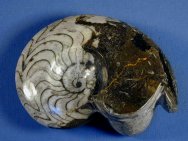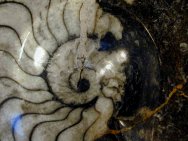|  Goniatites
are Ammonoids
with a distinctive goniotitic zig-zag pattern in the sutures that
mark the spiraling growth of the shell. The extinct ammonite that
decended from Nautiloids is an example of the remarkable symmetry
often found in nature. Mineral exchange over the eons can create
an amazing array of contrasting colors and the beautiful natural
display you see here. Ammonites were Cephalopods sharing a common
ancestor with the squid and octopus. The ammonites that appeared
in the Devonian became very diverse and widespread in the Paleozoic
and Mesazoic before going extinct along with the dinosaurs at the
end of the Cretaceous period. The goniatites lived early in the
Devonian period, some 400 million years ago, and became extinct
during the Permian period. Goniatites
are Ammonoids
with a distinctive goniotitic zig-zag pattern in the sutures that
mark the spiraling growth of the shell. The extinct ammonite that
decended from Nautiloids is an example of the remarkable symmetry
often found in nature. Mineral exchange over the eons can create
an amazing array of contrasting colors and the beautiful natural
display you see here. Ammonites were Cephalopods sharing a common
ancestor with the squid and octopus. The ammonites that appeared
in the Devonian became very diverse and widespread in the Paleozoic
and Mesazoic before going extinct along with the dinosaurs at the
end of the Cretaceous period. The goniatites lived early in the
Devonian period, some 400 million years ago, and became extinct
during the Permian period.
The
pictures tell the story of this large, beautifully polished display
fossil exhibiting a mixture of earth-tones. The thin walls between
the internal chambers of the shell are called the septa, and as
the goniatite grew it would move its body forward in the shell secreting
septa behind it, thereby adding new chambers to the shell. The sutures
(or suture lines) are visible as a series of narrow, wavy lines
on the surface of the shell. The sutures appear where each septa
contacts the wall of the outer shell.
|



